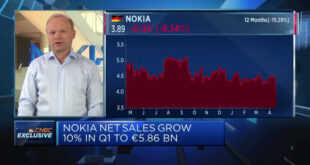
Bruno Levesque | IP3 | Getty Images
French fans attend the French football team parade on the Champs Elysees in a double-decker bus the day after their victory in the 2018 World Cup final, on July 16, 2018 in Paris, France. The French team won their second star after winning 4-2 against Croatia in the final.
The governing body of world soccer, FIFA, revealed that around half of the world’s population watched some part of the 2018 World Cup, according to audience data.
A combined 3.572 billion viewers — more than half of the global population aged four and over — tuned in to watch the month-long tournament in Russia during June and July.
The global in-home TV audience watching at least one minute of coverage totaled 3.262 billion. A further estimated 309.7 million people watched no coverage in their homes, but caught the action on digital platforms, including public viewing areas or in bars and restaurants, boosting the total audience by 9.5 percent.
“These figures really do support the claim that Russia 2018 was the best World Cup ever. We’re particularly pleased to see an increase in the average time viewers are engaging with matches, which shows that we are giving the fans what they want,” said FIFA’s Chief Commercial Officer Philippe Le Floc’h in a statement Friday.
The final between France and Croatia on July 15 attracted a combined global audience of 1.12 billion, comprising 884.37 million viewers tuning in to linear TV coverage and a further 231.82 million out-of-home and digital-only viewers.
The total viewing figures for the semi-finals and final were less than at the previous World Cup though, with the research putting that down to the lack of South American representation during that stage of the competition.
Over the 64 matches, the average live audience was 191 million: each game was a global televisual event in its own right.
However, the impact of the U.S. not featuring at a World Cup for the first time since 1986 may have been responsible for a drop in viewing figures across North America. Numbers in that region and the Caribbean were down 13.6 percent from the 2014 World Cup in Brazil.
There was a sharp rise in engagement across Africa and the Middle East though. 537 million people watched games, which was an increase of more than 66 percent. That rise potentially peaking due to five countries represented from those areas, compared to just two in 2014.
“The fact that half the world’s population watched the FIFA World Cup reflects not just the high quality of our award-winning live coverage, but also that fans everywhere are insatiable for world-class football,” said Le Floc’h.
The report also reveals that, on average, viewers watching on TV at home engaged with the coverage for longer than in previous FIFA World Cups. The number of viewers catching at least three minutes of the 2018 edition was 3.04 billion, a 10.9 percent increase on Brazil 2014. Meanwhile, the audience watching for at least 30 minutes was 2.49 billion, way up on 2014’s 1.95 billion viewers.
 EU News Digest Latest News & Updates
EU News Digest Latest News & Updates


